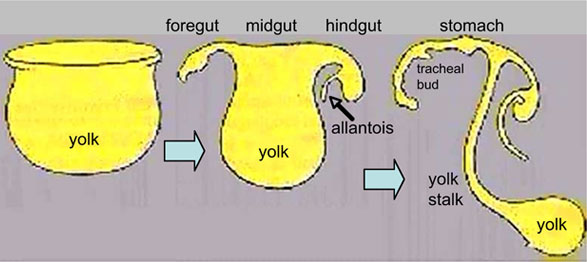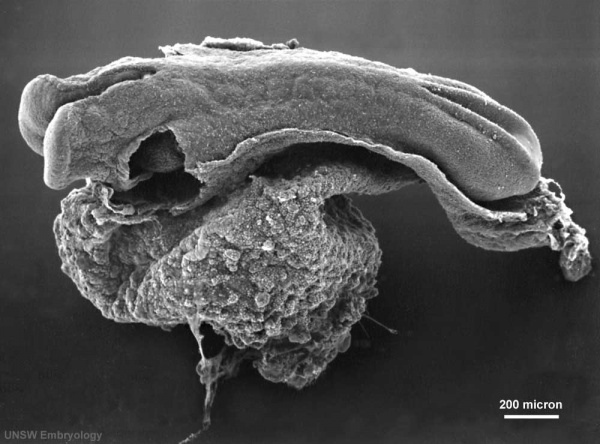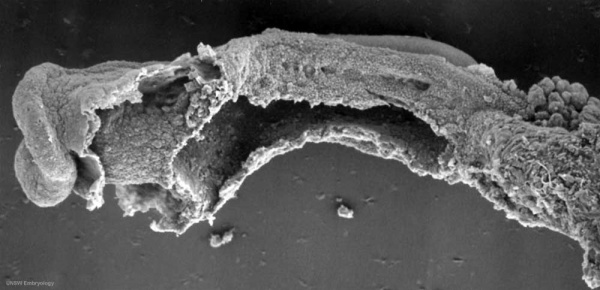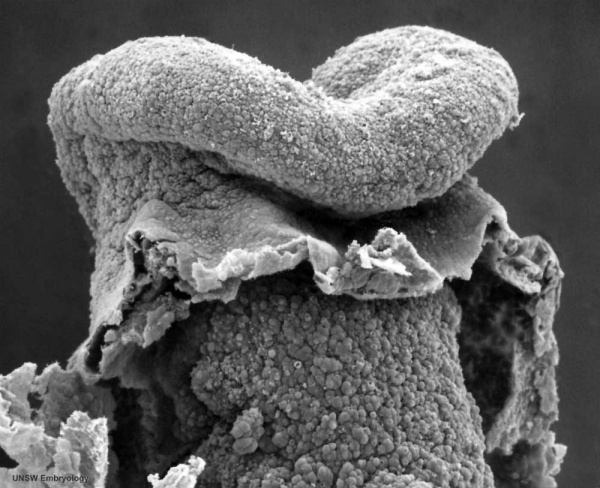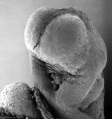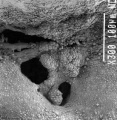ANAT2341 Lab 5 - Trilaminar Embryo: Difference between revisions
(Created page with "{{ANAT2341Lab5}} ==Introduction== Begin by very briefly covering the first 3 weeks of development. Our story of GIT development begins in the third week with the formation of ...") |
mNo edit summary |
||
| Line 28: | Line 28: | ||
The ventral endoderm (shown yellow) has grown to line a space called the yolk sac. Folding of the embryonic disc "pinches off" part of this yolk sac forming the first primative GIT. | The ventral endoderm (shown yellow) has grown to line a space called the yolk sac. Folding of the embryonic disc "pinches off" part of this yolk sac forming the first primative GIT. | ||
{| | {| | ||
| | | width=400px|<html5media height="540" width="390">File:Week3_folding.mp4</html5media> | ||
| < | |||
| | [[Media:Week3_folding.mp4|'''Click Here''' to play on mobile device]] | ||
| [[ | |||
| This animation shows folding of the embryonic disc beginning week 3 of development. | |||
Embryonic disc (midline section) shown to the left and early placenta to the right. The embryonic disc dorsal (ectoderm) top and ventral (endoderm) bottom. Cranial end of disc to the left and caudal end of disc to the right. | |||
Note also the early cardiac region shown at the cranial end of disc and the [[A#allantois|allantois]] at the caudal end of disc extending into the [[C#connecting stalk|connecting stalk]]. | |||
Folding of the embryonic disc | |||
# brings the cardiac region and [[A#allantois|allantois]] ventrally | |||
# brings the [[B#buccopharyngeal membrane|buccopharyngeal membrane]], [[C#cloacal membrane|cloacal membrane]] and connecting stalk ventrally | |||
# encloses the embryo in amniotic cavity | |||
# narrows the connection between yolk sac and midgut of the gastrointestinal tract to a channel, the [[Y#yolk stalk|yolk stalk]] or [[V#vitelline duct|vitelline duct]] | |||
* <font color=lightskyblue>'''blue'''</font> - epiblast layer of amniotic cavity | |||
* <font color=gold>'''yellow'''</font> - endoderm layer of the yolk sac and gastrointestinal tract | |||
* <font color=tomato>'''red'''</font> - outside embryo extraembryonic mesoderm and inside embryo mesoderm | |||
|} | |||
{| | |||
| width=320px|<html5media height="340" width="300">File:Endoderm 003.mp4</html5media> | |||
[[Media:Endoderm 003.mp4|'''Click Here''' to play on mobile device]] | |||
| [[File:Endoderm_002_icon.jpg|100px|left]] This animation shows the early development of [[E#endoderm|endoderm]] forming the gastrointestinal tract, [[Y#yolk sac|yolk sac]] and [[A#allantois|allantois]]. The movie starts approximately week 3 and continues through week 4. | |||
|} | |} | ||
Revision as of 10:33, 3 September 2014
| Lab 5: Introduction | Trilaminar Embryo | Early Embryo | Late Embryo | Fetal | Postnatal | Abnormalities | Online Assessment |
Introduction
Begin by very briefly covering the first 3 weeks of development. Our story of GIT development begins in the third week with the formation of the 3 germ cell layers, one layer the endoderm will form the lining of the entire gastrointestinal tract and also contibute the respiratory tract and other organs.
Note that the description below, and throughout the practical, has been substantially simplified.
Week 3
Gastrulation/Neuralation: The inner cell mass forms a flat sheet of cells and cells migrate through a specific region of the sheet (primitive streak) turning the single layer into first 2 then 3 layers (trilaminar embryo).
Folding
The next process to follow is the folding of the embryonic disc which will form the "tube" of the GIT. Forming the ends of this tube are the 2 membranes which form the upper and lower limits of the GIT.
Note that in addition to gastrulation, neuralation (forming the early neural tube that makes the nervous system) and somitogenesis (segmentation of the mesoderm forming the axial skeleton) are the other major processes occuring in week 3 to 4.
Folding of the embryonic disc occurs ventrally around the notochord, which forms a rod-like region running rostro-caudally in the midline.
In relation to the notochord:
- Laterally (either side of the notochord) lies mesoderm.
- Rostrally (above the notochord end) lies the buccopharyngeal membrane, above this again is the mesoderm region forming the heart.
- Caudally (below the notochord end) lies the primitive streak (where gastrulation occurred), below this again is the cloacal membrane.
- Dorsally (above the notochord) lies the neural tube then ectoderm.
- Ventrally (beneath the notochord) lies the mesoderm then endoderm.
The ventral endoderm (shown yellow) has grown to line a space called the yolk sac. Folding of the embryonic disc "pinches off" part of this yolk sac forming the first primative GIT.
| <html5media height="540" width="390">File:Week3_folding.mp4</html5media> | This animation shows folding of the embryonic disc beginning week 3 of development.
Embryonic disc (midline section) shown to the left and early placenta to the right. The embryonic disc dorsal (ectoderm) top and ventral (endoderm) bottom. Cranial end of disc to the left and caudal end of disc to the right. Note also the early cardiac region shown at the cranial end of disc and the allantois at the caudal end of disc extending into the connecting stalk. Folding of the embryonic disc
|
| <html5media height="340" width="300">File:Endoderm 003.mp4</html5media> | This animation shows the early development of endoderm forming the gastrointestinal tract, yolk sac and allantois. The movie starts approximately week 3 and continues through week 4. |
Week 4
Carnegie stage 10, 23 day, 5-11 somite pairs
Membranes
During the process of gastrulation the embryonic disc formed 3 layers, except in 2 specific membrane regions where ectoderm and endoderm have no mesoderm between them: buccopharyngeal membrane and cloacal membrane. These will form the upper and lower extend of the GIT.
Buccopharyngeal membrane
also called mouth or oral membrane
Carnegie stage 10 (21 days, 4-5 somite pairs, ventral sem)
Carnegie stage 11 (25 days, 20 somite pairs)
Cloacal membrane - not clearly visible in the above section
Splanchnic Mesoderm
The cartoon above is a section through the trunk of the trilaminar embryo showing the further development of the 3 layers and the space (coelom) that forms in the mesoderm (only the righthand side is shown, lefthand side would be identical).
Within the embryonic disc lateral plate mesoderm a space (coelom) forms, it lies within the embryo and so is called the intraembryonic coelom. This single "horseshoe-shaped" space will form the 3 major body cavities: pericardial (around the heart), pleural (around the lungs) and peritoneal (around the GIT and visceral organs).
The mesoderm adjacent to the endoderm is now called the splanchnic mesoderm which forms the connective tissue and muscular wall of the GIT.
Note intraembryonic coelomic cavity communicates with extraembryonic coelom (space outside the embryo) through portals (holes) initially on lateral margin of embryonic disc.
| Lab 5: Introduction | Trilaminar Embryo | Early Embryo | Late Embryo | Fetal | Postnatal | Abnormalities | Online Assessment |
Glossary Links
- Glossary: A | B | C | D | E | F | G | H | I | J | K | L | M | N | O | P | Q | R | S | T | U | V | W | X | Y | Z | Numbers | Symbols | Term Link
Cite this page: Hill, M.A. (2024, April 23) Embryology ANAT2341 Lab 5 - Trilaminar Embryo. Retrieved from https://embryology.med.unsw.edu.au/embryology/index.php/ANAT2341_Lab_5_-_Trilaminar_Embryo
- © Dr Mark Hill 2024, UNSW Embryology ISBN: 978 0 7334 2609 4 - UNSW CRICOS Provider Code No. 00098G
